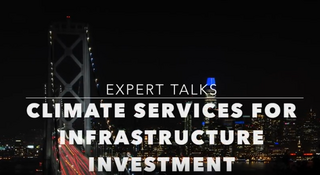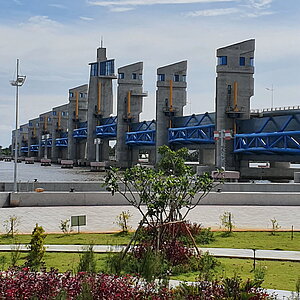Risk analyses to improve adaptations to the impact of the climate

Rice and shrimp cultivation in Viet Nam's Mekong Delta is under threat by an ingress of salt water arising from climate change. To prevent this, flood barriers with support from the IKI were constructed based on a climate risk analysis that was carried out.
At the end of a hot December day, farmer Nguyễn Thành Đồng is standing with his family in front of his house, surveying his fields. Yellow stalks of rice grow in shallow water over an area of less than three football fields.
Đồng lives in An Biên district of Kien Giang province in the southwestern part of the Mekong Delta with his family of ten, consisting of three generations living under one roof. They live off agriculture and have to survive on the equivalent of approximately 2,200 euros a year, which is an average income for the region.
Rice and shrimp as the economic backbone
The Mekong Delta covers an area of 39,000 square kilometres, and is as large as the Netherlands. Over 18 million people live in this region. Similar to the Netherlands, large parts of the delta are only a few centimetres above sea level – with the rest below sea level. Living in the Mekong Delta therefore requires you to "live with water": in terms of not only water shortages but also flooding caused by storms along the western and eastern coastline.
Food production is the economic backbone of the region. The 13 provinces in the Mekong Delta supply several million people worldwide with rice and is considered the rice bowl of Viet Nam. However, the region also offers ideal conditions for shrimp farming. Shrimps live in brackish water, a mixture of salt and fresh water, which is prevalent in the Mekong Delta in the foreshore, coastal hinterland and along the canal systems.
Farmer Đồng in the Kien Giang province has changed his farming methods in recent years. He continues to grow rice in the rainy season, but in the dry season, he floods his fields with the brackish water from the canals to cultivate shrimp. These generate higher revenues than cereal cultivation.
Multiple impacts of climate change in the Mekong Delta
However, similar to all the farmers in the province, he is suffering from the consequences of climate change. Frequent drought, even in rainy seasons, is one of the typical extreme weather events that have occurred repeatedly in Viet Nam's history. The droughts have not only become more frequent over the past few years, but are also increasing in intensity. “Serious droughts occurred in 2015, 2016, 2019 and 2020. We had crop failures in all those years, but 2016 was the worst - we lost almost the entire harvest," says farmer Đồng.

In the Mekong Delta, drought does not only mean less rainfall for crops but reduction in water levels in some canals as the Mekong no longer supplies them with sufficient quantities of fresh water. The impacts of drought from climate change are also exacerbated by other factors: the operation of large dams in the other riparian states on the upper reaches of the Mekong causing less water to reach other areas. To make up for this additional shortage, farmers in the Mekong Delta are increasingly using groundwater to irrigate their rice fields, which in turn has caused drinking water shortages and soil subsidence in some districts.
The lack of rainfall is not the only problem. The warming of the oceans is leading to a rise in sea levels causing extreme weather events such as storm flooding.
Flooding and drought cause a greater ingress of saltwater, known as saltwater intrusion. This disrupts the balance between the fresh and saltwater, which is necessary for the formation of brackish water, and destroys the basis of life for the shrimps. Saltwater intrusion also salinises the soil, destroys rice crops and threatens the underground freshwater resources.
Barriers to prevent saltwater intrusion

To protect against floods and the growing danger of saltwater intrusion, Kien Giang province has built 56 small and medium-sized flood barriers, similar to those on the North Sea coast or along the Rhine. Some barriers open and close daily to balance the water budget.
Larger flood barriers are only active on some days when the capacities of the smaller waterworks are insufficient due to increased saltwater intrusion. This includes Viet Nam's largest sluice gate, the Cai Lon - Cai Be, completed in 2021.It protects shrimp farming during the dry season and the farmers' rice harvests when storm flooding occurs.
The planning and construction of barriers are part of the Vietnamese government's adaptation strategy. As in the Netherlands, a controversial debate is ongoing in Viet Nam about whether the cost of the barriers justifies the benefits - or if it would be more practical to cease rice cultivation and focus on fish farming.
However, many farmers seem to want to continue growing rice, as many fish farmers have not succeeded in switching from rice to aquaculture in the past. They favour the construction of barriers in line with the plan of the Vietnamese government. Rice thus remains a guarantor for Viet Nam's food security and is an important export commodity.
Considering climate risks in adaptation decisions
The Deutsche Gesellschaft für Internationale Zusammenarbeit (GIZ) (German Agency for International Cooperation) was involved in providing advice and preparing climate risk analyses through the project "Improved Climate Services for Infrastructure Investments (CSI)", funded by the International Climate Initiative (IKI). The project has been advising ministries, authorities and decision-makers in Brazil, Costa Rica, the Nile Basin and Viet Nam since 2017 to ensure that needs-based climate information and risk assessments (climate services) are used when planning infrastructure projects.
The CSI project conducted various risk analyses during construction and after completion of the Cai Lon - Cai Be sluice gate. The focus was on the negative effects that current and future climate risks could have on the structure. This was mainly on the building structure and the potential basic restrictions on functionality that could arise in the short, medium or long term. This is to prevent damage from climate change, minimise costs and ensure the functionality of the barrier.
Greater protection from lightning, improved concrete and other coatings for the sluice gates
The existing threshold values for the load of the planned structural components of the barrier was investigated and incorporated into the climate information, which engineers, climate scientists and consultants combined into various risk matrix evaluations. The calculations were based on two climate scenarios that classify increases in longer, extreme dry periods and frequent flood and storm events with higher risks of lightning strikes as probable.
The design of the structure was changed to protect the sensitive electronics from lightning strikes based on the findings of the analysis. High-quality concrete and epoxy coatings prevent the locks from corrosion and, on the advice of the IKI project, the condition of these elements are closely monitored during regular maintenance inspections. In addition, process flows were changed to align with operations during extreme weather events and contingency plans.
Although these adaptations entailed additional costs, a cost-benefit analysis linked to the analyses shows a positive relationship of the adaptation measures from both an economic and public welfare perspective.
In addition to the Cai Lon - Cai Be sluice gate, the project conducted a less detailed screening analysis of all 84 existing and planned small and medium-sized barriers in the province, based on updated and local climate information for Kien Giang province. The results help the Vietnamese government to set priorities in the adaptation strategy.
The hopes of farmer Đồng and his family also rest on these results. Adapted agricultural production methods alone will not be enough to secure the yields from rice cultivation and shrimp farming and the drinking water supply in Kien Giang Province in the Mekong Delta in the future.
The link has been copied to the clipboard
Contact
IKI Office
Zukunft – Umwelt – Gesellschaft (ZUG) gGmbH
Stresemannstraße 69-71
10963 Berlin
PIEVC analysis protocol
The project was supported by the German Weather Service (DWD) and the Canadian Engineers Association (Engineers Canada), who provided risk analysis advice based on the PIEVC climate risk analysis protocol compiled in Canada. The method helps the actors with infrastructure planning, construction and operation to assess the climate risks for individual infrastructures or entire infrastructure portfolios. As the name ‘protocol’ suggests, the PIEVC describes a step-by-step approach that is designed to meet the needs of engineers and other actors in the field. The conclusions and recommendations from the application also form the basis for decision-making at various stages of the infrastructure cycle, from planning to operation and maintenance.
Interview

The most important partner of the IKI Global Project in Viet Nam is the Ministry of Planning and Investment (MPI), which finances major investments in the country's infrastructure, working closely with line ministries and provinces. In the interview, Dr Nguyen Thi Dieu Trinh, Deputy Director General of the Department of Science, Natural Resources and Environment, , explains the challenges of adapting to the impacts of climate change in Viet Nam and how the activities of the IKI project are helping to address them.


















